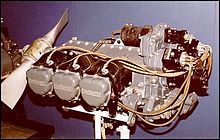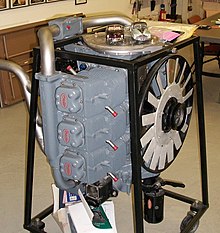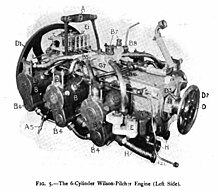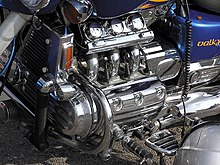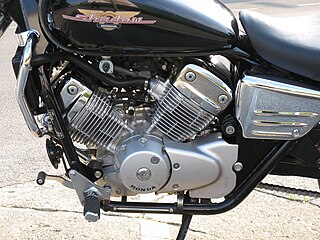
A V-twin engine, also called a V2 engine, is a two-cylinder piston engine where the cylinders are arranged in a V configuration and share a common crankshaft.
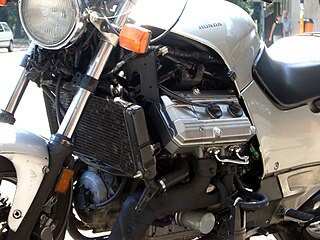
A V4 engine is a four-cylinder piston engine where the cylinders share a common crankshaft and are arranged in a V configuration.
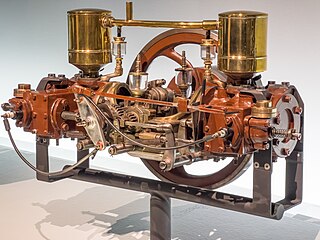
A flat engine is a piston engine where the cylinders are located on either side of a central crankshaft. Flat engines are also known as horizontally opposed engines, however this is distinct from the less common opposed-piston engine design, whereby each cylinder has two pistons sharing a central combustion chamber.

A flat-twin engine is a two-cylinder internal combustion engine with the cylinders on opposite sides of the crankshaft. The most common type of flat-twin engine is the boxer-twin engine, where both pistons move inwards and outwards at the same time.

A flat-four engine, also known as a horizontally opposed-four engine or boxer engine, is a four-cylinder piston engine with two banks of cylinders lying on opposite sides of a common crankshaft. The most common type of flat-four engine is the boxer-four engine, each pair of opposed pistons moves inwards and outwards at the same time.

A straight-twin engine, also known as an inline-twin, vertical-twin, or parallel-twin, is a two-cylinder piston engine whose cylinders are arranged in a line along a common crankshaft.

A flat-twelve engine, also known as a horizontally opposed-twelve, is a twelve-cylinder piston engine with six cylinders on each side of a central crankshaft.

A straight-four engine is a four-cylinder piston engine where cylinders are arranged in a line along a common crankshaft.

In car tuning culture, an engine swap is the process of removing a car's original engine and replacing it with another. This may be a like-for-like replacement, or to install a non-factory specification engine. Typically, an engine swap is performed for performance, swapping-in a more powerful engine; however, an engine swap may also be performed for maintenance, where older engines may have a shortage of spare parts, and so a modern replacement may be more easily and cheaply maintained.

The Chevrolet Turbo-Air 6 is a flat-six air-cooled automobile engine developed by General Motors (GM) in the late 1950s for use in the rear-engined Chevrolet Corvair of the 1960s. It was used in the entire Corvair line, as well as a wide variety of other applications.

The Pietenpol Air Camper is a simple parasol wing homebuilt aircraft designed by Bernard H. Pietenpol. The first prototype that became the Air Camper was built and flown by Pietenpol in 1928.
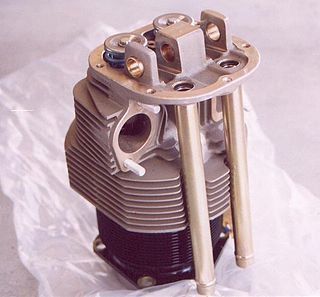
Air-cooled engines rely on the circulation of air directly over heat dissipation fins or hot areas of the engine to cool them in order to keep the engine within operating temperatures. Air-cooled designs are far simpler than their liquid-cooled counterparts, which require a separate radiator, coolant reservoir, piping and pumps.

A motorcycle engine is an engine that powers a motorcycle. Motorcycle engines are typically two-stroke or four-stroke internal combustion engines, but other engine types, such as Wankels and electric motors, have been used.
A flat-eight engine, also called a horizontally-opposed eight, is an eight-cylinder piston engine with two banks of four inline cylinders, one on each side of a central crankshaft, 180° apart.

The Subaru EA engine is a series of automobile internal combustion engines manufactured by Subaru, a division of Fuji Heavy Industries. All EA series engines are of a flat-4 design, and have always been water cooled.

A V8 engine is an eight-cylinder piston engine in which two banks of four cylinders share a common crankshaft and are arranged in a V configuration.
Turbochargers have been used on various petrol engines since 1962, in order to obtain greater power or torque output for a given engine displacement.
German carmaker Porsche built several series of flat-eight engines of differing displacements over the course of many years. They were mainly used in Porsche's racing cars.
The Porsche Type 573 engine is a naturally-aspirated, flat-eight racing engine, designed by Porsche for Formula One racing; and used for a single season in 1962 in the 1½ litre formula.
